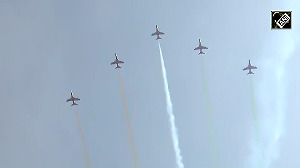Cricketers colliding with the Establishment is not a new phenomenon, especially not in Indian cricket.
When Indian cricket was in its infancy, there were odd incidents of an individual player or two rebelling against the all-powerful Board of Control for Cricket in India (BCCI) in the past. Lala Amarnath, the stormy petrel of Indian cricket, was sent home in the middle of the England tour in 1936 following his feud with the team management, for instance.
But cricketers learnt to get united and fight for their rights (read financial interests) only in the 1980s.
After India's unexpected win in the 1983 World Cup, money began to pour in from patrons and sponsors. The BCCI was happy enough to fill its coffers, but reluctant to share the bonanza with the players, and even to allow them to earn money from other sources.
Despite a prohibitory clause in their contracts, Sunil Gavaskar, Kapil Dev and Ravi Shastri used to write syndicated columns in newspapers and magazines. The BCCI, which in any case has always been reluctant to take on Sunil Gavaskar in particular, winked at the practice. But matters came to a head when the players commenced wearing their respective sponsors' logos without the BCCI's permission, when the 1987 World Cup on the subcontinent was just round the corner.
A few weeks before the showpiece event, the BCCI slapped a fine of Rs. 5,000 each on Kapil Dev, Gavaskar, Shastri, Dilip Vengsarkar, Krishnamachari Srikkanth, Kiran More, Shivlal Yadav, Maninder Singh and Raman Lamba. Srikkanth was doubly unfortunate:
During the previous Test series, a Mumbai daily had carried piece under his byline. Though he pleaded ignorance, claiming his name had been used without his knowledge, the BCCI ordered him to get a letter of apology from the newspaper concerned or shell out another Rs. 5,000 as fine!
Meanwhile the BCCI selected 14 players for the 1987 World Cup, asked them to sign new contracts and fixed a date to submit them. These contracts were full of clauses which prevented them from earning extra income, including by writing syndicated columns in print media and wearing the logos of their individual sponsors, while making it mandatory to wear the logo of Reliance Industries, the official sponsors of the World Cup.
The players refused to sign the contracts. Their main objection, according to the Indian team captain Kapil Dev, was about compulsorily wearing the World Cup sponsors' logo while being prohibited from sporting the logos of their own sponsors.
Then BCCI secretary Ranbir Singh kept saying the players would relent and sign the contracts, but also hinted that India would field a new team in the event of the status quo. The players however refused to back down -- and the BCCI, as host of the World Cup, finally had to give in and offer fresh contracts that were marginally better.
Kapil Dev was sacked from captaincy after India lost to England in the semi-final in Mumbai and was replaced by Vengsarkar, for the Test series against the West Indies in 1987-88. Vengsarkar hit brilliant hundreds against the West Indies attack, spearheaded by Patrick Patterson and Courtney Walsh, in Delhi and Kolkata.
The "Colonel" defied the BCCI ruling and started writing columns, arguing that since his counterpart Vivian Richards was writing in newspapers and expressing his views in public, he should also write to counter the Antiguan.
But the BCCI was not amused and issued him a "show cause" notice. Vengsarkar handed over his reply to Ranbir Singh on the rest day of the Kolkata Test. But he got injured at Eden Gardens, missed the rest of the series, and continued to write in newspapers even as the BCCI served him yet another notice.
Once the West Indians left India, the BCCI swung into action. At a Special Meeting in Mumbai on February 3, 1988, the BCCI officials took a "unanimous" decision and banned Vengsarkar from playing for Mumbai and India for 6 months, in addition to a fine of Rs. 10,000. Sensing possible boycott threats from the Vengsarkar loyalists within the Indian team, the BCCI also announced that any player refusing to represent India would not be considered for selection for one entire year.
Vengsarkar seemed to have taken the punishment sportingly. He claimed that his team-mates had given him a signed statement, pledged complete support and were even ready to jeopardize their India careers if he was not reinstated. But he said he was happy to have their moral support and asked them to give priority to the country.
Shastri led India in Vengsarkar's absence, winning the Chennai Test against the West Indies on the strength of leggie Narendra Hirwani's 16-wicket haul on debut, and the Sharjah Cup.
Vengsarkar became eligible again and was given back his rightful place in the Indian team for the Champions Trophy in Sharjah and the Asia Cup in Bangladesh in 1988-89. For the home series against the Kiwis in 1989, the BCCI strictly prohibited the captain, the players, and even the manger from writing syndicated columns.
The Indian team fared badly in the West Indies in early 1989, and Vengsarkar criticised his players in no uncertain terms, calling some of them "cowards". The BCCI, already upset by the team's pathetic performance in the Caribbean, was livid because in spite of its warning, half-a-dozen prominent Indian players headed for US and Canada, instead of returning home, and played some friendly matches there.
On August 6, 1989, a disciplinary committee comprising the BCCI president B N Dutt, I S Bindra, P M Rungta, Madhav Mantri and A W Kanmadikar banned Vengsarkar, Kapil Dev, Shastri, Mohammad Azharuddin, Kiran More and Arun Lal for one year and fined them for violating the West Indies tour contracts in order to make a fast buck by playing in the US and Canada.
For the first time, the players took a united stand, took the BCCI to court, and won the three-month legal battle after the Supreme Court intervened and castigated the officialdom.
To begin with, a Division Bench consisting of Chief Justice E S Venkataramaiah and Justice K N Singh directed the BCCI to opt for an out-of-court settlement. But the latter wanted to "teach a lesson" to the "rebels". Many BCCI affiliated state associations filed petitions, arguing that disciplinary actions against players by an autonomous sports body were a private affair and was not open to judicial scrutiny.
Eight topnotch journalists of the country, including Kuldip Nayar, countered this by filing an intervention application, claiming that if the order punishing the players was unfair, unjust and unsatisfactory, nobody could stop the victims from taking recourse to court. Renowned cricket journalist R Mohan, too, had played a pivotal role in constantly helping, guiding and supporting to the hilt the banned six players.
The players' counsel Soli Sorabjee took the BCCI to task for trying to clip the cricketers' wings by not allowing them to voice their feelings about the "absurd" terms and conditions and giving them no real choice in either accepting or rejecting the contracts.
"If a player who refuses to sign the contract cannot play even Ranji Trophy matches, it is virtually a violation of a citizen's right to freedom of action," remarked Chief Justice E S Venkataramaiah. "Are the BCCI officials beyond criticism and in a much more exalted position than the Prime Minister? Even we judges are being criticized every day," he added, referring to a particular term of contract that prohibited the players from criticizing any BCCI official.
"It is just like bonded labor. If you are selected, you cannot speak, go anywhere, play or write," said Justice K N Singh.
With such unprecedented criticism from everywhere, particularly from the Supreme Court, the BCCI was bound to cave in. At last, it lifted the ban on the six players at its "extraordinary" Working Committee meeting in Mumbai.
Tensions between players and the board have simmered ever since; the ongoing contracts dispute however threatens to be a flashpoint. The BCCI attempted to strike after the World Cup, hoping to catch the players on a sticky wicket following the team's premature exit. The players currently are stalling, hoping that a good performance on the Bangladesh tour will restore some of their lost credibility.
Stand by, then, for further action on the domestic front -- the battle is a long way from being over.






